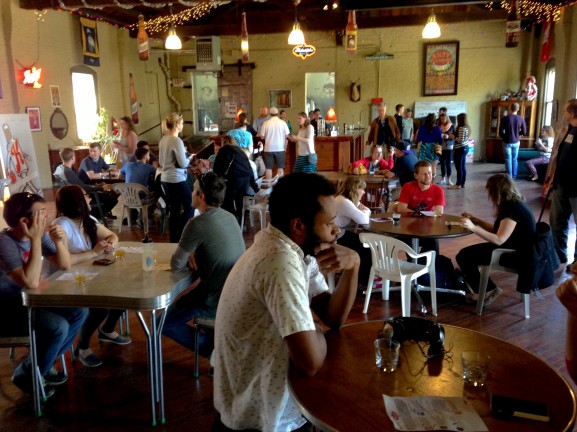
The number of American breweries is at a record-breaking high since the first breweries set up shop in 1887.
Not far behind California—the state with the most breweries—is Pennsylvania, which tied with Wisconsin in 10th place for the nation’s most breweries per-state according to the most current Beer Institute statistics. The state’s licensed breweries is steadily increasing, with 10 new breweries opening their doors in just a two-year span between 2010 and 2012.
One of the nation’s current 2,538 breweries is East Kensington-based Philadelphia Brewing Company.
Bill Barton, co-owner of PBC, has been in the $246.5 million beer industry for 16 years. The company delivered its first keg of Kenzinger to Northern Liberties in 2008.
Before moving into the company’s current building, Barton was leasing space to brew beer in Roxborough, which he now realizes wasn’t conducive to the craft with its flat floors and lack of drains.
Barton and his wife, Nancy, stumbled upon the former the location of Weisbrod and Hess Oriental Lager Brewery while driving around killing time in the neighborhood before a meeting with an area beer distributor. The former brewery employed 32 workers after opening its doors in 1882 and quickly expanded to employ 100 before Prohibition. It reopened for five years following Prohibition but ultimately closed its doors for good in the late 1930s.
Though the building’s exterior appeared abandoned and conditions of the surrounding area looked bleak at the time, Barton saw potential on the inside.

“It just kind of found us—we got really lucky,” said Barton. “Being a brewery and opening up in an old brewery was pretty cool.”
The building is also the site of New Kensington Community Development Corporation’s (NKCDC) meetings. Barton collaborated on an initiative with NKCDC for a cleanup on Frankford Avenue spanning from Lehigh to Girard avenues, which sparked the relationship between the brewery and NKCDC. The corporation meets monthly and sponsors a number of initiatives such as the Kensington Kinetic Sculpture Derby, Real Estate Development Projects and Blight Busters Ball. PBC donates beer, cider and soda to neighborhood events.
PBC has been brewing in the building for 13 years. The company—and industry as a whole which sold 15.6 million barrels of beer last year, up from 2012’s 13.2 million barrels—continues to expand today.
Barton and his team at the time began cleaning out the space, scraping the walls, sanding the floor and painting shortly after moving in. The process is ongoing, according to Barton. Currently, Barton is working to transform part of the building used for storage into a new area for filtration.
Upon initially opening in East Kensington, the brewery used to supply beer to six states, including Rhode Island, Connecticut and Virginia.
“We were all over,” said Barton. “But we weren’t selling a lot of beer in Northeast Philly or South Philadelphia. We were missing those neighborhoods, so it seemed kind of weird to drive a truckload of beer up to Rhode Island when we weren’t selling beer in our own backyard.”
The company has since redefined its way of doing business and now sells all of its beer exclusively in Pennsylvania. The majority of it goes to neighborhoods in Philadelphia. All of it is ordered by bars and restaurants and delivered directly from PBC in its own trucks, a factor that brings the company back to the way breweries used to operate, pre-Prohibition era.
(Click the photo below for an interactive chart of the growth of U.S. breweries)
In 1887, there were 2,269 breweries in the nation. The number of breweries fluctuated over the course of the next 20 years, approximately, and then faced a steady decline leading up to Prohibition. The first specialty brewery sprung up in 1966, which now makes up the majority of breweries open today.
Pennsylvanians, specifically, love their beer—in 2012, each person of legal drinking age in the state consumed 28.6 gallons of beer on average, ranking just behind Alaska and Illinois.
Though Barton knows the ins and outs of the multimillion dollar industry today, he said the learning process was gradual and based on a lot of initial trial and error batches of beer, before founding PBC.
“I basically learned the beer business by us making a lot of bad beer,” he said. “It was a lot of hard work. I just refused to give up.”
Barton estimates upward of 5,000 batches of beer were brewed in PBC’s East Kensington location. The company brews seasonal batches, like spring’s Fleur de Lehigh, ciders, like the Gregarious Ginger, and year-round brews, like the well-known Kenzinger and Walt Wit.

After graduating from Rutgers with a degree in economics, Barton initially took a job at an automobile auction house where he played the role of a bank and an insurance company rolled into one, he said. He later became interested in exploring new beer options that were available at the time and teamed up with a neighbor to test the waters with home brewing about four to five years before the opportunity to get into the business arose.
“Making beer is tangible,” said Barton. “What the beer’s going to taste like, what ingredients we’re going to use, what’s the label going to look like, what’s the box going to look like—all that kind of stuff that goes into it is very tangible. Where I worked was an industry where nothing was tangible. I was really attracted to being more hands on.”
On Saturdays beginning at noon, the brewery opens its doors for free tours and complimentary tastings of three year-round beers, one seasonal brew and two year-round ciders.
Text, Images and Video by Mark Whited and Lauren Arute



Be the first to comment